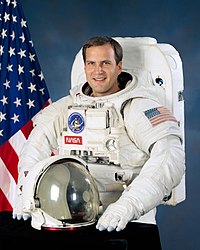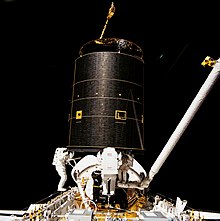Richard Chop
| Richard Chop | |
|---|---|

|
|
| Country: | United States |
| Organization: | NASA |
| selected on | June 4, 1985 ( 11th NASA Group ) |
| Calls: | 3 space flights |
| Start of the first space flight: |
April 28, 1991 |
| Landing of the last space flight: |
July 23, 1994 |
| Time in space: | 31d 22h 34min |
| EVA inserts: | 3 |
| EVA total duration: | 17h 38min |
| retired on | April 3, 1995 |
| Space flights | |
Richard James Hieb (born September 21, 1955 in Jamestown , North Dakota ) is a former American astronaut .
education
Hieb received a bachelor's degree in mathematics and physics from Northwest Nazarene College in 1977 and a masters degree in aerospace engineering from the University of Colorado in 1978 .
Astronaut activity
In 1979 Hieb came to NASA and initially worked there in the development and planning of tasks for the space travelers. He worked in the control center in the team that was responsible for the start of the first space shuttle mission STS-1 and supported numerous subsequent missions. After an unsuccessful application for the tenth group of astronauts, Hieb was selected by NASA as a member of the eleventh group in June 1985.
STS-39
On April 28, 1991, Hieb started as a mission specialist with the space shuttle Discovery . STS-39 was the Department of Defense's first non-secret shuttle mission . Only the MPEC experiment was classified as secret on this mission. Furthermore, the southern polar lights were examined, various experiments were carried out and several small satellites were exposed.
STS-49
On May 7, 1992, Hieb flew into space for the second time as a mission specialist on the maiden flight of the space shuttle Endeavor . The aim of this mission was to salvage the Intelsat VI-F3 communications satellite , which had been launched two years earlier, for repair. It was not until the third external mission (EVA) that the satellite could finally be captured by hand. As a result, Intelsat received a new apogee motor so that it could enter a designated geostationary orbit . Structures and tools were tested at another EVA.
STS-65
For the STS-65 mission , Hieb flew as a mission specialist with the space shuttle Columbia on July 8, 1994 for the third time into space. Around ninety experiments from the fields of biology and materials science were on the program during the 15-day Spacelab flight. On July 23, the Columbia landed at the Kennedy Space Center in Florida .
According to NASA
In 1995, Hieb left NASA and then worked for Allied Signal Technical Services Corporation in Greenbelt . He is currently Vice President, Civil Programs at Lockheed Martin Mission Services.
Richard Hieb is married and has two children.
See also
Web links
- Short biography of Richard Hieb at spacefacts.de
- NASA biography of Richard Hieb (English; PDF)
- Biography of Richard blow in the Encyclopedia Astronautica (English)
| personal data | |
|---|---|
| SURNAME | Chop, Richard |
| ALTERNATIVE NAMES | Chop, Richard James (full name) |
| BRIEF DESCRIPTION | American astronaut |
| DATE OF BIRTH | September 21, 1955 |
| PLACE OF BIRTH | Jamestown , North Dakota |
